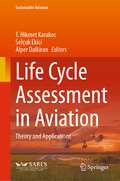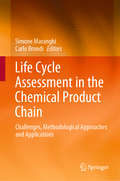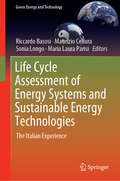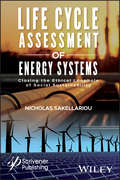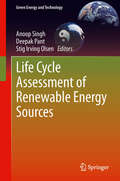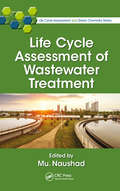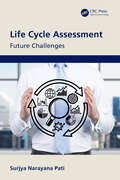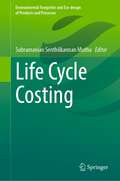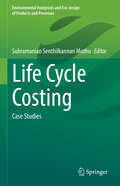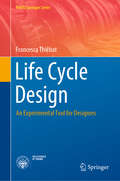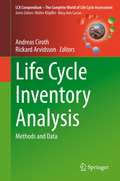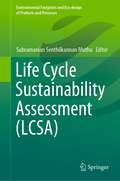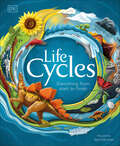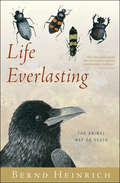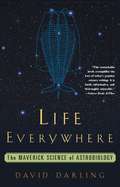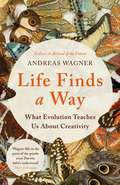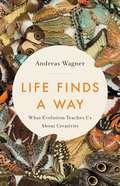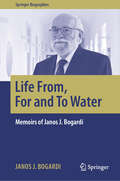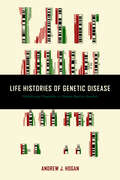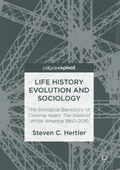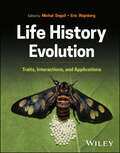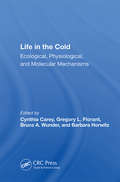- Table View
- List View
Life Cycle Assessment in Aviation: Theory and Applications (Sustainable Aviation)
by T. Hikmet Karakoc Alper Dalkiran Selçuk EkiciLife Cycle Assessment in Aviation: Theory and Applications provides readers with a comprehensive analysis that examines various elements within the aviation sector, including aircraft operations, maintenance and repair activities, aircraft gas turbine engine processes, airport auxiliary vehicles, airport operations, airport construction, airport access traffic, and airport wastes. The book’s content has been meticulously crafted to address the specific needs and interests of a diverse audience encompassing researchers, engineering students, and civil aviation organization officials. Readers will find valuable insights and up-to-date information about the latest developments in the aviation field, serving as a valuable resource for their investigations and studies.
Life Cycle Assessment in the Chemical Product Chain: Challenges, Methodological Approaches and Applications
by Simone Maranghi Carlo BrondiThis book outlines the methodologies, approaches and tools for modelling chemicals in a Life Cycle Assessment (LCA) perspective, and also covers the main advantages and drawbacks of applying LCA to chemical processes. In the first part of this book, authors pay close attention to the limitations of modelling the environmental and social impacts of chemical processes, providing valuable insights to the problems of the Life Cycle Inventory (LCI) analysis for chemical processes. In the second part of this book, readers will learn about the LCA application to chemical processes in the laboratory and industrial scale. In each chapter of this book, readers will also find specific case studies on the modelling and application of LCA in the chemical industry.
Life Cycle Assessment of Energy Systems and Sustainable Energy Technologies: The Italian Experience (Green Energy and Technology)
by Riccardo Basosi Maurizio Cellura Sonia Longo Maria Laura ParisiThis book deals with the application of life cycle assessment (LCA) methodology to sustainable energy systems and technologies. It reviews the state-of-the-art of the Italian experiences on the LCA applied to energy, and the most recent results from research in this field, with a particular focus on renewables, bio-energy and sustainable solutions. The contributors describe in detail the applications of LCA to various energy system topics, including: • electricity production, smart energy grids and energy storage systems;• renewable energy production from biomass;• production of biodiesel from microalgae;• environmental impacts of biomass power plants; and• geothermal energy production. These topics are supported by critical reviews and case studies, with discussions of Italian examples, demonstrating LCA’s application to various energy systems. A particular focus is placed on bio-energies and bio-energy systems, demonstrating how LCA can be used for optimal bio-energy production. This book offers an opportunity for researchers and advanced practitioners in the field of LCA to learn more about the application of LCA methodology to energy systems and technologies. It will also be of interest to students, as it enables them to understand the environmental impacts of energy systems and sustainable energy technologies, through the analysis of their life cycles.
Life Cycle Assessment of Energy Systems: Closing the Ethical Loophole of Social Sustainability
by Nicholas SakellariouEnergy and sustainability are two of the most important and often most misunderstood subjects in our world today. As these two subjects have grown in importance over the last few decades, interest in the Life Cycle Assessment (LCA) model has grown as well, as a potentially crucial tool in understanding and striving towards sustainability in energy systems. Not just wind and solar systems, but all energy systems, need to be understood through this model. Wind and solar power have the potential to decentralize the U.S. energy system by offering local communities electricity and economic support, depending on the scale and design of projects. Nevertheless, every energy technology potentially faces environmental costs, lay and expert opposition, and risks to public health. Engineers play a central role as designers, builders, and operators in energy systems. As they extend their expertise into electrical, mechanical and chemical fields, from fossil fuel-based systems to renewable energy systems, “sustainability” is steadily becoming one of the key criteria engineers apply in their work. This groundbreaking new study argues that engineering cultures foster sustainability by adopting assumptions and problem-solving practices as part of their identities when designing and building engineering projects. This work examines the politics of creating, utilizing, and modifying Life Cycle Assessment (LCA) in the construction of renewable energy systems. The only volume of its kind ever written, it is a must-have for any engineer, scientist, manager, or other professional working in or interested in Life Cycle Assessment and its relation to energy systems and impact on environmental and economic sustainability.
Life Cycle Assessment of Renewable Energy Sources
by Anoop Singh Deepak Pant Stig Irving OlsenGovernments are setting challenging targets to increase the production of energy and transport fuel from sustainable sources. The emphasis is increasingly on renewable sources including wind, solar, geothermal, biomass based biofuel, photovoltaics or energy recovery from waste. What are the environmental consequences of adopting these other sources? How do these various sources compare to each other? Life Cycle Assessment of Renewable Energy Sources tries to answer these questions based on the universally adopted method of Life Cycle Assessment (LCA). This book introduces the concept and importance of LCA in the framework of renewable energy sources and discusses the key issues in conducting their LCA. This is followed by an in-depth discussion of LCA for some of the most common bioenergy sources such as agricultural production systems for biogas and bioethanol, biogas from grass, biodiesel from palm oil, biodiesel from used cooking oil and animal fat, Jatropha biodiesel, lignocellulosic bioethanol, ethanol from cassava and sugarcane molasses, residential photovoltaic systems, wind energy, microalgal biodiesel, biohydrogen and biomethane. Through real examples, the versatility of LCA is well emphasized. Written by experts all over the globe, the book is a cornucopia of information on LCA of bioenergy systems and provides a platform for stimulation of new ideas and thoughts. The book is targeted at practitioners of LCA and will become a useful tool for researchers working on different aspects of bioenergy.
Life Cycle Assessment of Wastewater Treatment (Life Cycle Assessment and Green Chemistry Series)
by Mu. NaushadLife Cycle Assessment of Wastewater Treatment addresses in detail the required in-depth life cycle assessment of wastewater treatment. This is to meet the special demands placed upon wastewater treatment processes, due to both the limited quantity and often low quality of water supplies. Wastewater management clearly plays a central role in achieving future water security in a world where water stress is expected to increase. Life cycle assessment (LCA) can be used as a tool to evaluate the environmental impacts associated with wastewater treatment and potential improvement options. This unique volume will focus on the analysis of wastewater treatment plants (WWTPs), using a life cycle assessment (LCA) approach. Key Features: Focuses on the analysis of wastewater treatment plants using a life cycle assessment (LCA) approach Discusses unconventional water sources such as recycled wastewater, brackish groundwater and desalinated seawater Explains life cycle assessment in detail, which has become one of the reference methods used to assess the environmental performance of processes over their complete life cycle, from raw material extraction, infrastructure construction and operation to final dismantling Explores a technique (LCA) that is becoming increasingly popular amongst researchers in the water treatment field nowadays because of its holistic approach Based on the real life experiences, the subject of wastewater is presented in simple terms and made accessible to anyone willing to learn and experiment
Life Cycle Assessment: Future Challenges
by Surjya Narayana PatiThis book offers an itemized analysis of Life Cycle Assessment (LCA), for use in any processes, products, services, industries, organizations and so forth. Various challenges faced during applications of LCA, and its extension are discussed including their benefits. Further, the book provides practical examples of LCA in different core sectors, such as cement and construction. Each chapter functions as a stand-alone unit within the book and defines its individual role within the overall concept of LCA. Features: Covers Life Cycle Assessment (LCA) and future challenges including its practical applications as climate change tool. Connects life cycle management and LCA/environmental management. Explains benefits of LCA studies for both internal and external purpose in terms of various impact parameters. Identifies different raw materials or alternate energy mediums for changing inputs to reduce environmental impacts. Discusses extension of LCA concept like LCC, LCSA, SCLA, and OLCA. This book is aimed at professionals in all engineering areas and environmental studies.
Life Cycle Costing (Environmental Footprints and Eco-design of Products and Processes)
by Subramanian Senthilkannan MuthuLife Cycle Costing (LCC) is a well-known and popular method to evaluate the economic sustainability, which as the term implies is structured on the life cycle of a product or process. LCC is a method primarily consisting of estimating the total cost of a product, taking into account the whole life cycle of the product as well as the direct and external costs. It is one of the important methods and tools under the sustainability umbrella. This book describes the concept of LCC and offers several interesting case studies.
Life Cycle Costing: Case Studies (Environmental Footprints and Eco-design of Products and Processes)
by Subramanian Senthilkannan MuthuThis volume offers several case studies detailing Life Cycle Assessment practices across a variety of industries. Particular focus is placed on materials used in renewable energy efforts and in buildings and construction. This volume can be of use to academics, students, professionals, and anyone else interested in making industry more sustainable.
Life Cycle Design: An Experimental Tool for Designers (PoliTO Springer Series)
by Francesca ThiebatThis book proposes an economic and environmental assessment tool to help private and public building designers and owners determine the global sustainability value of green buildings from a life cycle perspective. As it demonstrates, sustainable life cycle tools for building design and construction can help to achieve successfully integrated architecture. The first part of the book defines the relationship between environmental and economic aspects in a sustainable design approach and illustrates how life cycle methodologies, including Life Cycle Assessment and Life Cycle Costing, can be applied to life cycle design. Further, it highlights methods for calculating costs from LCA data, taking into consideration both discounted cash flow and external costs. In turn, the second part of the book presents an experimental design model, the Life Cycle Design Model (LCDM), which is based on a life cycle design approach that can be used to produce two different outcomes based on two assessment levels. The first assessment level involves creating a grid, called a Design Matrix, which is useful in the design process. The second assessment level involves drawing on LCA and LCC results to develop a user-friendly tool for designers and other actors involved in the building process so that they can assess the most sustainable design option using €CO, a factor that combines the environmental and energy effects of the building system with time and costs. Selected case studies illustrate the practical application of life cycle analysis and show how reflecting the environmental impacts and costs can improve the sustainability of buildings. The LCDM represents a transdisciplinary tool for the design team and, at the same time, allows information on users’ needs and building performance to be communicated between experts and non-experts.
Life Cycle Inventory Analysis: Methods and Data (LCA Compendium – The Complete World of Life Cycle Assessment)
by Andreas Ciroth Rickard ArvidssonLife Cycle Inventory (LCI) Analysis is the second phase in the Life Cycle Assessment (LCA) framework. Since the first attempts to formalize life cycle assessment in the early 1970, life cycle inventory analysis has been a central part. Chapter 1 “Introduction to Life Cycle Inventory Analysis“ discusses the history of inventory analysis from the 1970s through SETAC and the ISO standard. In Chapter 2 “Principles of Life Cycle Inventory Modeling”, the general principles of setting up an LCI model and LCI analysis are described by introducing the core LCI model and extensions that allow addressing reality better. Chapter 3 “Development of Unit Process Datasets” shows that developing unit processes of high quality and transparency is not a trivial task, but is crucial for high-quality LCA studies. Chapter 4 “Multi-functionality in Life Cycle Inventory Analysis: Approaches and Solutions” describes how multi-functional processes can be identified. In Chapter 5 “Data Quality in Life Cycle Inventories”, the quality of data gathered and used in LCI analysis is discussed. State-of-the-art indicators to assess data quality in LCA are described and the fitness for purpose concept is introduced. Chapter 6 “Life Cycle Inventory Data and Databases“ follows up on the topic of LCI data and provides a state-of-the-art description of LCI databases. It describes differences between foreground and background data, recommendations for starting a database, data exchange and quality assurance concepts for databases, as well as the scientific basis of LCI databases. Chapter 7 “Algorithms of Life Cycle Inventory Analysis“ provides the mathematical models underpinning the LCI. Since Heijungs and Suh (2002), this is the first time that this aspect of LCA has been fundamentally presented. In Chapter 8 “Inventory Indicators in Life Cycle Assessment”, the use of LCI data to create aggregated environmental and resource indicators is described. Such indicators include the cumulative energy demand and various water use indicators. Chapter 9 “The Link Between Life Cycle Inventory Analysis and Life Cycle Impact Assessment” uses four examples to discuss the link between LCI analysis and LCIA. A clear and relevant link between these phases is crucial.
Life Cycle Sustainability Assessment (Environmental Footprints and Eco-design of Products and Processes)
by Subramanian Senthilkannan MuthuEnvironmental Life Cycle Assessment (ELCA) that was developed about three decades ago demands a broadening of its scope to include lifecycle costing and social aspects of life cycle assessment as well, drawing on the three-pillar or ‘triple bottom line’ model of sustainability, which is the result of the development of the Life Cycle Sustainability Assessment (LCSA). LCSA refers to the evaluation of all environmental, social and economic negative impacts and benefits in decision-making processes towards more sustainable products throughout their life cycle. Combination of environmental and social life cycle assessments along with life cycle costing leads to life cycle sustainability assessment (LCSA). This book highlights various aspects of life cycle sustainability assessment (LCSA).
Life Cycles: Everything from Start to Finish (DK Life Cycles)
by DKTake a look into the circle of life through the life cycles of the planet and everything on it!Everything begins and everything ends — but what happens in between? Find out in this stunning nature book. Learn about human life and development, processes in nature, how animals change over time, how the universe was formed and so much more. This illustrated children&’s book for ages 7-11 includes: • More than 60 life cycles featured • Stunning photographs that capture key moments during a life cycle, like penguin chicks huddling together to keep warm and the beauty of an orchid in full bloom • Bite-size facts and stats about every animal, plant, planet and habitat featured • A great new angle on the world, the universe and our place in it If you&’re looking for facts about the universe then this is the book for you! Based on key concepts found in the STEM learning curriculum, Life Cycles captures life on the planet through captivating illustrations and photography, amazing facts and easy-to-read text. You&’ll take a closer look at the life cycles of environments, and extinct animals like the dinosaurs, too! The life cycles in this reference book have been carefully chosen to give you an amazing overview of the universe, and how everything is linked. Discover a new life cycle every time you turn the page: how a river forms and changes over time, how a tree grows, see how coral reefs form. Follow the life cycles of weather — from the water cycle to ice ages, to give you a better idea of the climate change we find ourselves in now.From the single-celled amoeba, mountains, and volcanoes to continents, oceans and the solar system — take a deeper look into life on earth and all its intricacies!
Life Cycles: Reflections of an Evolutionary Biologist
by John Tyler BonnerThe author combines an intensely personal memoir of scientific progress and an overview of what we now know about living things.
Life Everlasting: The Animal Way of Death
by Bernd HeinrichAn enlightening look at animal behavior and the cycle of life and death, from &“one of the finest naturalists of our time&” (Edward O. Wilson). When a good friend with a severe illness wrote, asking if he might have his &“green burial&” at Bernd Heinrich&’s hunting camp in Maine, it inspired the acclaimed biologist to investigate a subject that had long fascinated him. How exactly does the animal world deal with the flip side of the life cycle? And what are the lessons, ecological to spiritual, imparted by a close look at how the animal world renews itself? Heinrich focuses his wholly original gaze on the fascinating doings of creatures most of us would otherwise turn away from—field mouse burials conducted by carrion beetles; the communication strategies of ravens, &“the premier northern undertakers&”; and the &“inadvertent teamwork&” among wolves and large cats, foxes and weasels, bald eagles and nuthatches in cold-weather dispersal of prey. Heinrich reveals, too, how and where humans still play our ancient and important role as scavengers, thereby turning not dust to dust, but life to life. &“If it has not been clear to readers by now, this book confirms that Bernd Heinrich is one of the finest naturalists of our time. Life Everlasting shines with the authenticity and originality that are unique to a life devoted to natural history in the field.&” —Edward O. Wilson, author of The Meaning of Human Existence and The Social Conquest of Earth
Life Everywhere
by David DarlingTo many people, the main question about extraterrestrial life is whether it exists. But to the scientific community, that question has already been answered: it does, and within our solar system. The new science of astrobiology is already being practiced at NASA's Astrobiology Institute and the University of Washington's new Department of Astrobiology. Life Everywhere is the first book to lay out what the new science of astrobiology is all about. It asks the fascinating questions researchers in astrobiology are asking themselves: What is life? How does it originate? How often does life survive once it arises? How does evolution work? And what determines whether complex or intelligent life will emerge from more primitive forms? Informed by interviews with most of the top people in this nascent field, this book introduces readers to one of the most important scientific developments of the next century.
Life Finds a Way: What Evolution Teaches Us About Creativity
by Andreas Wagner&‘This is a wonderful, mind-expanding book. Prepare to be surprised, enlightened and awed as Wagner reveals the sources of human and natural creativity.&’ – Alice RobertsIn Darwin&’s survival of the fittest, each step must be uphill as life progresses towards an evolutionary peak. There is no turning back. So what happens when life needs to cross a valley in the wilds of an adaptive landscape to reach the highest summit? World-renowned biologist Andreas Wagner reveals that life does not only walk – it also leaps. Drawing on pioneering research, Wagner explores life&’s creative process and how it bears a striking resemblance to how we humans work. A beguiling symmetry links Picasso struggling through forty versions of Guernica and the way evolution transformed a dinosaur&’s claw into a condor&’s wing. This new understanding is already revolutionising our approach to problem-solving across the sciences. In the near future, applied in spheres as diverse as the economy and education, it will enable us to do so much more. Life Finds a Way is a thought-provoking and deeply hopeful look at the force that shapes our world.
Life Finds a Way: What Evolution Teaches Us About Creativity
by Andreas WagnerHow the principles of biological innovation can help us overcome creative challenges in art, business, and scienceIn Life Finds a Way, biologist Andreas Wagner reveals the deep symmetry between innovation in biological evolution and human cultural creativity. Rarely is either a linear climb to perfection--instead, "progress" is typically marked by a sequence of peaks, plateaus, and pitfalls. For instance, in Picasso's forty-some iterations of Guernica, we see the same combination of small steps, incessant reshuffling, and large, almost reckless, leaps that characterize the way evolution transformed a dinosaur's grasping claw into a condor's soaring wing. By understanding these principles, we can also better realize our own creative potential to find new solutions to adversity.Ultimately, Life Finds a Way offers a new framework for the nature of creativity, enabling us to better adapt, grow, and change in art, business, or science--that is, in life.
Life From, For and To Water: Memoirs of Janos J. Bogardi (Springer Biographies)
by Janos J. BogardiThis book is translated from Hungarian. It was originally published as the sixth volume of the "Building the Future in Water Resources Management" series of the Water Science Council of the Hungarian Water Resources Management Directorate. It presents the water resources management of the last 50 plus years as seen, experienced, co-shaped and narrated by Janos Bogardi, a research professor of the Ludovika University of Public Service in Budapest. The author is simultaneously co-opted professor at the University of Bonn and distinguished adjunct professor of the Asian Institute of Technology, Pathumthani, Thailand. Born into a water resources engineering family and growing up in Budapest close to the Danube river pre-determined his professional orientation. He describes with light irony, and without the usual memoir style, his search for a fulfilling professional life. He discusses his engagement with the inter-university cooperation helping the transition of Central European universities earning him numerous academic recognitions. Dr. Bogardi’s career culminated with assignments as science diplomat and manager, working at UNESCO with local scientists in Central Asia, Russia and in Africa. He served as founding director of the UNU Institute for Environment and Human Security. The book concludes with reminiscences to those whose influence and collaboration shaped Dr. Bogardi’s career.
Life Histories of Genetic Disease: Patterns and Prevention in Postwar Medical Genetics
by Andrew J. HoganA history of genetic testing warns that such tests may tell us more than we want to know.Medical geneticists began mapping the chromosomal infrastructure piece by piece in the 1970s by focusing on what was known about individual genetic disorders. Five decades later, their infrastructure had become an edifice for prevention, allowing today’s expecting parents to choose to test prenatally for hundreds of disease-specific mutations using powerful genetic testing platforms. In Life Histories of Genetic Disease, Andrew J. Hogan explores how various diseases were "made genetic" after 1960, with the long-term aim of treating and curing them using gene therapy. In the process, he explains, these disorders were located in the human genome and became targets for prenatal prevention, while the ongoing promise of gene therapy remained on the distant horizon.In narrating the history of research that contributed to diagnostic genetic medicine, Hogan describes the expanding scope of prenatal diagnosis and prevention. He draws on case studies of Prader-Willi, fragile X, DiGeorge, and velo-cardio-facial syndromes to illustrate that almost all testing in medical genetics is inseparable from the larger—and increasingly "big data"–oriented—aims of biomedical research. Hogan also reveals how contemporary genetic testing infrastructure reflects an intense collaboration among cytogeneticists, molecular biologists, and doctors specializing in human malformation.Hogan critiques the modern ideology of genetic prevention, which suggests that all pregnancies are at risk for genetic disease and should be subject to extensive genomic screening. He examines the dilemmas and ethics of the use of prenatal diagnostic information in an era when medical geneticists and biotechnology companies have begun offering whole genome prenatal screening—essentially searching for any disease-causing mutation. Hogan’s focus and analysis is animated by ongoing scientific and scholarly debates about the extent to which the preventive focus in contemporary medical genetics resembles the aims of earlier eugenicists. Written for historians, sociologists, and anthropologists of science and medicine, as well as bioethics scholars, physicians, geneticists, and families affected by genetic conditions, Life Histories of Genetic Disease is a profound exploration of the scientific culture surrounding malformation and mutation.
Life History Evolution and Sociology
by Steven C. HertlerThis book supplies the evolutionary and genetic framework that Charles Murray, towards the end of Coming Apart: The State of White America 1960-2010, predicts will one day explain revolutionary change in American society. Murray's Coming Apart documents 50 years of changed college admissions, government incentives, mating and migration patterns that have wrought national divisions across indexes of marriage, industriousness, honesty, and religiosity. The framework discussed is life history evolution, a sub-discipline within evolutionary biology singly capable of explaining why violent crime, property crime, low marriage rates, father absence, early birth, low educational achievement, low income, poverty, lack of religiosity and reduced achievement striving will reliably co-occur as part of a complex. This complex augments facultatively, developmentally and evolutionarily in response to unpredictable and uncontrollable sources of mortality. The uncertain tenure of life wrought by unpredictable and uncontrollable mortality selects for a present-oriented use of bioenergetics resources recognizable as the social ills of Fishtown, Murray's archetypal working class community. In turn, the thirty years of life history literature herein reviewed confirms the biological logic of elite intermarriage and sequestration. The source of life history variation, policy implications, and demography are discussed.
Life History Evolution: A Biological Meta-Theory for the Social Sciences
by Steven C. Hertler Aurelio José Figueredo Mateo Peñaherrera-Aguirre Michael A. Woodley of Menie Heitor B. FernandesThe social sciences share a mission to shed light on human nature and society. However, there is no widely accepted meta-theory; no foundation from which variables can be linked, causally sequenced, or ultimately explained. This book advances “life history evolution” as the missing meta-theory for the social sciences. Originally a biological theory for the variation between species, research on life history evolution now encompasses psychological and sociological variation within the human species that has long been the stock and trade of social scientific study. The eighteen chapters of this book review six disciplines, eighteen authors, and eighty-two volumes published between 1734 and 2015—re-reading the texts in the light of life history evolution.
Life History Evolution: Traits, Interactions, and Applications
by Eric Wajnberg Michal SegoliProvides a timely and authoritative account of Life History Evolution by a multidisciplinary team of scholars and researchers from around the world Life History Evolution: Traits, Interactions, and Applications presents a cutting-edge synthesis of the mechanisms driving life history strategies that span the breadth of taxa, from bacteria to humans. Integrating classical and contemporary perspectives, this comprehensive volume addresses how organisms evolve traits in response to diverse ecological pressures. Editors Michal Segoli and Eric Wajnberg bring together leading experts to explore the intersection of evolutionary biology, ecology, and applied research, focusing on the evolving complexity of life history traits and their implications. In-depth yet accessible chapters cover a broad spectrum of life history traits, from classical traits of lifespan and reproduction to more complex interactions like social behaviour, predator-prey dynamics, and human-induced evolutionary processes. The contributing authors explain essential concepts, identify critical knowledge gaps, discuss future research directions, and demonstrate the relevance of life history evolution in addressing climate change, species invasion, pollution, and more. Providing a well-balanced understanding of life history traits and their implications, Life History Evolution: Incorporates recent advances in evolutionary theory, including eco-evolutionary feedback loops and anthropogenic impacts Offers diverse perspectives and original research from leading experts in fields such as evolutionary biology, ecology, entomology, zoology, agriculture, and veterinary medicine Discusses life history evolution in the context of co-evolved interactions such as predator-prey, parasite-host, plant-herbivore, and endosymbiont-host relationships Provides an overview of the foundational theory, recent developments, and current thinking in the field Features numerous case studies that highlight real-world applications in biological control, wildlife management, climate change adaptation, and others Revealing how life history traits shape the evolutionary strategies of organisms, Life History Evolution: Traits, Interactions, and Applications is an essential resource for undergraduate and graduate students, researchers, industry professionals, and policymakers in ecological science. It is an ideal textbook for courses in evolutionary ecology, evolutionary biology, conservation biology, environmental science, and environmental management.
Life In A Pond
by Carol K. LindeenText and photographs introduce ponds, and includes information on the plants found in ponds such as water lilies and cattails, and animals found in ponds such as fish, frogs, and ducks.
Life In The Cold: Ecological, Physiological, And Molecular Mechanisms
by Cynthia CareyContributors present the newest information on ecological, physiological, neurological, cellular and biochemical mechanisms by which vertebrates deal with seasonal cold.
